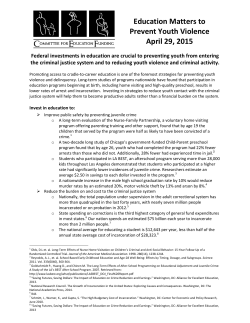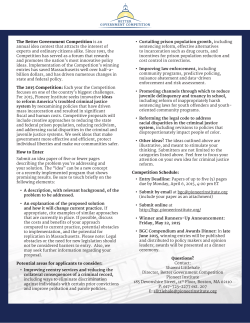
How do we Change the Record?
How do we Change the Record? To Change the Record, we need to work with Aboriginal and Torres Strait Islander communities to invest in holistic early intervention, prevention and diversion strategies. These are smarter, evidence-based and more cost-effective solutions that increase safety, address the root causes of violence against women and children, cut reoffending and imprisonment rates, and build stronger communities. Here is our list of what needs to be done: 1. Invest in communities, not prisons Evidence clearly demonstrates that strong, healthy communities are the most effective way to prevent crime and make communities safe. Prisons have been shown to be extremely costly, damaging and ultimately ineffective at reducing crime. Every dollar spent on prisons is one less dollar available to invest in reducing social and economic disadvantage through education, health, disability, housing, employment and other programs. Government funding must be reinvested into initiatives that address the underlying causes of crime. 2. Local communities have the answers Directly affected people are best placed to identify local issues in their community and implement local solutions. Aboriginal and Torres Strait Islander community controlled organisations provide culturally appropriate services, and are able to develop localised, tailored solutions that have the support of the community. 3. Recognise the driving factors of imprisonment Along with the experience of poverty and disadvantage, involvement in the child protection system and family violence are two of the clearest indicators of people who are more likely to end up in the criminal justice system. Early intervention strategies to prevent crime must include measures to stop domestic violence and avoid exposure to the child protection system by supporting families and strengthening communities. These strategies will decrease imprisonment rates. 4. Focus on safety The impacts of crime are felt most keenly by people in that community, particularly women and children who are the victims of violent behaviour. Successful early intervention and prevention strategies will not only cut offending and imprisonment rates, but importantly will increase safety by addressing the root causes of violence against women and children and building stronger communities. 5. Services, not sentences The criminal justice system is often an ineffective or inappropriate way to look after people who have a disability or are experiencing poverty, mental illness, drug or alcohol addiction, homelessness or unemployment. We need a social policy and public health response to such issues, not a criminal justice one. Services like adequate health care, disability supports, employment and training, drug treatment and affordable housing cost far less than prisons, and have a substantially better record of success. 6. Community policing, not policing the community Police have an enormously important and often difficult role to play in dealing with offending behaviour and keeping us all safe. However, for many communities their experience of police includes overpolicing, harassment and racism, which can sometimes exacerbate the situation for already marginalised and disadvantaged communities. Changes to the ways police interact with and enforce the law in communities experiencing poverty and disadvantage can play a vital role in building trust, promoting safety, reducing crime and building stronger communities. 7. Smarter sentencing The hallmark of a justice system is fairness. Harsher sentences and laws that strip judges of their ability to make the sentence fit the crime, such as mandatory sentencing, need to be changed. A wider range of sentencing alternatives encompassing non-custodial options enables judges to ensure that sentences are tailored, fair and appropriate. 8. Eliminate unnecessary imprisonment Many people are locked up because they could not pay off fines or were convicted for relatively minor offences. In many instances, sending a person to prison is unnecessary and can contribute to further involvement in the criminal justice system. We need to rethink the costly practice of keeping people behind bars and consider more effective community options. 9. Adopt community justice approaches Serious crime, particularly violent offending, damages individuals and communities, and impacts women and children disproportionately. Evidence tells us that therapeutic and restorative processes, such as Koori and Murri courts, drugs courts and healing circles, are ways in which the criminal justice system can help to rebuild relationships and deliver positive outcomes for the entire community. 10. Young people don’t belong in prison Punitive ‘tough on crime’ approaches to youth offending and misbehaviour fail to recognise that young people are still developing and that far more appropriate opportunities for support and positive reinforcement exist than putting children behind bars. Exposure to youth detention also substantially increases the likelihood of involvement in crime as an adult. As much as possible, at risk young people must be supported to maximise their chances of achieving their full potential. 11. Rehabilitation, not just punishment A prison sentence should not be a sentence for life. Just about every prisoner will be released back into the community at some stage. It is in all of our interests to ensure that people in prison are not just punished, but that there is an appropriate focus on rehabilitation that includes education, programs and support services. 12. Reintegration not recidivism Unfortunately far too many people fall back into crime soon after being released from prison. This tells us that not enough support is being providing to people while in prison and in their transition back into the community. Better support needs to be provided to assist people to lead productive lives and fulfil their potential, which includes the provision of affordable housing, health care, and training and employment.
© Copyright 2025











